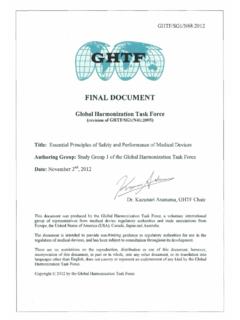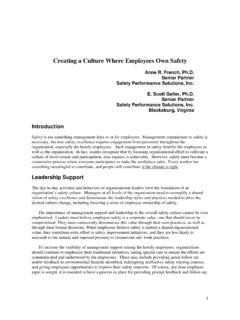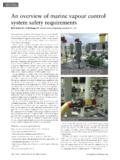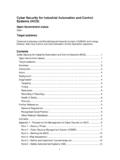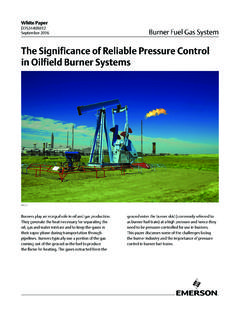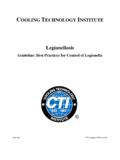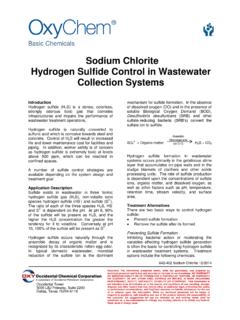Transcription of COMAH Competent Authority - Health and Safety Executive
1 COMAH Competent Authority Inspection of Electrical, control and Instrumentation Systems at COMAH Establishments (Operational Delivery Guide) Page 1 of 23 Page 2 of 23 Introduction 1 This Delivery Guide (DG) describes how the COMAH Competent Authority (CA) inspects Electrical, control and Instrumentation (EC&I) aspects of control of major hazards at COMAH sites. Its purpose is to ensure consistency within the regulation of COMAH and to provide transparency to Operators about what is expected and the way inspector resource is targeted. 2 The guide includes the benchmark standards that are used to assess the way Operators manage risk.
2 They represent a consensus between regulators, technical experts, duty holders and other stakeholders on what constitutes proportionate action to control a given hazard. Electrical, control and Instrumentation engineering is supported by comprehensive established standards that should not require further interpretation. 3 Not all of the benchmark standards contained in the guide are necessarily applicable at every establishment. The Operator should already be aware of the hazards and risks at their establishment and hence which benchmark standards are applicable. 4 In particular, for aspects of nuclear facilities and installations that may be subject to COMAH , the benchmark standards specified in Annex 2 may not be applicable where other nuclear sector standards have been used in their design, construction, installation, operation, use and maintenance.
3 In such cases, information on relevant nuclear sector standards that may form a benchmark for EC&I inspections by the CA can be provided by the Office for Nuclear Regulation. 5 There is a comprehensive range of guidance documents available from professional institutions and trade associations which can be helpful to Operators in meeting the benchmark standards in this delivery guide. This delivery guide does not list these guidance documents specifically as there are many such documents from different organisations, often addressing the same subject-matter. 6 Whilst primarily aimed at HSE EC&I inspectors, this guide will be useful to Operators in managing risk in relation to major accident hazards and preparing for CA inspections.
4 Justification 7 Failure to control process conditions and the risks from electrical installations and equipment have been the main or underlying cause in many major accidents both in the UK and abroad including Buncefield and BP Texas City. HSE research into the causation of major accidents and incidents indicates that failure to adequately control process conditions, especially during normal operations, is responsible for the loss of containment of hazardous substances. 8 In many processes and activities undertaken at COMAH establishments, EC&I equipment and systems provide important prevention and mitigation measures against major accidents.
5 Examples include: instrumented process Safety measures such as trips, alarms and interlocks (including Safety instrumented systems); protection against electrical sources of ignition; protection against large releases of electrical energy, and; reliability and availability of utilities. Page 3 of 23 Scope 9 The EC&I specialist discipline covers three priority topics: functional Safety ; explosive atmospheres, and; electrical power systems. Functional Safety 10 Functional Safety is concerned with the management, design, installation, operation and maintenance of instrumented process Safety systems that reduce the risk of a major accident.
6 Such systems include: process control systems; Safety instrumented systems; alarm systems. Explosive Atmospheres 11 In the context of the EC&I inspection, explosive atmospheres is concerned with the management, design, installation, operation and maintenance of systems that reduce the risk of electrical sources of ignition arising from: electrical and instrumentation equipment; lightning; static; radio frequency radiation; cathodic protection; and the mitigation of releases using: flammable and toxic gas detection; fire detection. Electrical Power Systems 12 In the context of major accident hazards, electrical power systems are concerned with: the initiation of major accidents by electrical equipment through fire and explosion; the management, design, installation, operation and maintenance of electrical power systems so that they provide the necessary reliability and availability to prevent or mitigate major accidents and so that they prevent danger to personnel.
7 EC&I Inspection Process 13 An EC&I inspection should address one or more of the following elements of one or more of the EC&I priority topics in order to assess Operator risk management performance against relevant good practice: hazard and risk assessment; specification, design and engineering; operation and maintenance; underpinned by: Competent people; an effective Safety Management System. There may be circumstances where the inspector may decide to inspect areas other than in this guide, because of specific known issues or issues identified at site during the inspection. Targeting 14 The CA will prioritise which sites to inspect and the order of inspection based on inherent hazards, duty holder performance on a range of topics and other intelligence in accordance with the COMAH Competent Authority Site prioritisation methodology (ref 3), HID Targeting & Prioritisation methodology (ref.)
8 1), and other relevant CA procedures. EC&I inspectors will follow the principles set out in the HID Regulatory Model (ref. 2). 15 Regardless of their performance, COMAH Operators will be subject to a degree of periodic inspection to provide public reassurance that major accident hazards continue to be managed appropriately. Sampling 16 An EC&I inspection should address one or more of the priority topics in sufficient detail to determine performance against relevant good practice. The topics selected should examine and test the effectiveness of critical EC&I control measures relating to the major hazard scenarios relevant for the establishment.
9 Inspectors will focus on and test in detail the most important layers of protection and accident prevention barriers and the systems which support them. They will use their professional judgement to decide how deeply to probe Operator performance and the underlying causes of failure before they make a regulatory decision. 17 The standards and good practice relevant to the technical benchmarks that apply to Electrical and Instrumentation Engineering on major hazard sites are set out in Annex 2. An overview of the inspection process is shown in Figure 1. Intervention Planning Sample Inspection Performance Rating Regulatory Decisions sampling an operator s major hazard management arrangements Figure 1: Overview of the EC&I inspection process Page 4 of 23 Page 5 of 23 18 Annex 3 of this guide also provides inspection templates that can be used to record the performance rating arising from inspections.
10 Making Regulatory Decisions 19 Evidence gathered during inspection should be used to derive enforcement decisions in accordance with the CA Enforcement Management Model. EC&I sources of evidence could include: risk assessment studies; specifications; design documents; calculations; equipment certificates and manuals; maintenance procedures; maintenance records; test and inspection records; competence records; compliance against Safety management system procedures; field observations, including information provided verbally by the Company. Evidence of compliance may be gathered on site or may be received after the site inspection if further information was requested.











